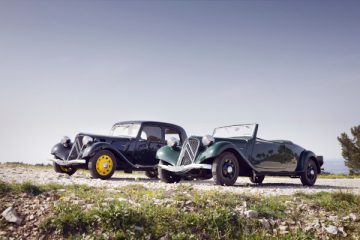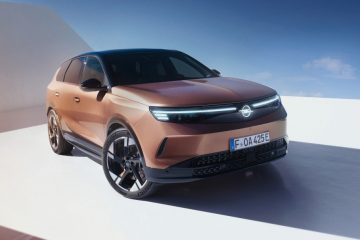 In autumn 2010, ŠKODA rounded off its GreenLine range of ecological models, and is now pressing ahead with further environmental – Green tec – models at the 2011 Geneva Motor Show. This new name is used to indicate vehicles with lower fuel consumption and CO2 emissions. Following on from the initial Octavia Green tec and Octavia Combi Green tec, delivered with the 1.6 TDI CR DPF/77 kW diesel engine, which debuted at the 2010 Paris Motor Show in the autumn, Fabia, Roomster and the Octavia versions with petrol engines are not being launched. The wider selection of engines gives customers freedom of choice in each power class, including the option of an environmentally-friendly version. The Green tec package shares GreenLine technology and the related aerodynamic modifications, in combination with an almost unlimited choice of optional equipment.
In autumn 2010, ŠKODA rounded off its GreenLine range of ecological models, and is now pressing ahead with further environmental – Green tec – models at the 2011 Geneva Motor Show. This new name is used to indicate vehicles with lower fuel consumption and CO2 emissions. Following on from the initial Octavia Green tec and Octavia Combi Green tec, delivered with the 1.6 TDI CR DPF/77 kW diesel engine, which debuted at the 2010 Paris Motor Show in the autumn, Fabia, Roomster and the Octavia versions with petrol engines are not being launched. The wider selection of engines gives customers freedom of choice in each power class, including the option of an environmentally-friendly version. The Green tec package shares GreenLine technology and the related aerodynamic modifications, in combination with an almost unlimited choice of optional equipment.
The 1.2 12V HTP/51 kW, 1.2 TSI/63 kW and 1.2 TSI/77 kW engines are available for the Fabia Green tec and Fabia Combi Green tec. Customers can order the Roomster Green tec with a 1.2 TSI/63 kW or 1.2 TSI/77 kW engine. The Octavia expands the range of Green tec versions by offering a 1.4 TSI/90 kW petrol engine. This is the first time that Start-Stop and energy regeneration systems will be associated with petrol engines.
Significantly reduced CO2 emissions
The main aim of the newly developed efficient technology was to reduce CO2 emissions. In the Fabia and Fabia Combi with the 1.2 12V HTP/51 kW engine, the difference between the normal version and the Green tec version is 9 g of CO2 per kilometre; with emissions of 119 g/km, both cars are among the most efficient cars in their class. These values were achieved not only by means of Start-Stop and brake energy regeneration systems, but also by fitting 15-inch tyres with reduced rolling resistance and a modified five-speed gearbox. The higher gears have been extended, allowing for lower revolutions at higher speeds and thus reduced fuel consumption.
The CO2 emissions of the 1.2 kW TSI/63 kW engine were reduced by 7 g/km to 114 g/km, or by 10 g/km to 124 g/km in the Roomster. The same values were achieved with the 1.2 TSI/77 kW engine thanks to the use of green technology.
The Octavia Green tec with the 1.4 TSI/90 kW engine can be ordered in two body versions – the liftback and the estate. The 200 Nm of torque available between 1,500 and 4,000 rpm gives the car the exceptional dynamism craved by even the most demanding customers. Nevertheless, the engine, coupled with the economical technology, is extremely efficient, consuming 5.9 litres per 100 km, equating to CO2 emissions of 137 g/km.
Green tec models can be identified by:
● a green square after the sign indicating a 1.2 12V HTP/51 kW engine;
● a green “i” in the sign indicating a 1.2 TSI/63 kW engine;
● a green “i” in the sign indicating a 1.2 TSI/77 kW engine (for the Octavia), accompanied by a green square after the engine sign (for the Fabia and Roomster).
GreenLine – cutting-edge technology
The GreenLine versions of all ŠKODA models are unquestionably excellent environmental and economical cars. Their fuel consumption and CO2 emissions are among the best-scoring in their categories (if not the very best in the case of the Roomster and Yeti), as confirmed by the high ratings from independent media and car clubs. They are fitted with the three-cylinder 1.2 TDI CR DPF/55 kW (Fabia and Roomster) or the four-cylinder 1.6 TDI CR DPF/77 kW diesel engine (Octavia, Superb and Yeti). All GreenLine versions are equipped with the same package of environmental measures, including:
● Start-Stop system
● brake energy regeneration
● engine control unit adjustments
● tyres with reduced rolling resistance
● aerodynamic modifications to the body and chassis
● “recommended gear” feature on the instrument panel
Practical GreenLine: Fabia and Roomster
These design features result in remarkable fuel savings and significantly reduce CO2 emissions. The combined consumption of the Fabia GreenLine and the Fabia Combi GreenLine is just 3.4 litres of diesel per 100 kilometres, with CO2 emissions of 89 g/km. The Roomster, a compact MPV with consumption of 4.2 litres per 100 kilometres, is the class leader. CO2 emissions are 109 g/km.
Family GreenLine: Octavia
The ŠKODA Octavia is available in two reduced-consumption versions. The first is the GreenLine, supplied as a liftback or an estate. The liftback has a combined consumption of 3.8 litres per 100 kilometres, with CO2 emissions of 99 g/km. This makes the Octavia GreenLine one of the greenest cars in its class. The second version, the Green tec, is also available in either of the Octavia bodies. In this design, selected elements of the GreenLine version come into play in a vehicle offering combined consumption of 4.2 litres per 100 kilometres and CO2 emissions of 109 g/km. The difference between the versions lies in the number of optional extras available. For example, the GreenLine version cannot be combined with a towing device, larger wheels or other features that significantly increase the weight of the car and hamper its aerodynamics. Naturally, equipment designed for passenger comfort, such as air conditioning or the audio system, is not restricted.
GreenLine for all roads: Yeti
ŠKODA Yeti is proud proof that even an SUV can achieve low consumption and emissions. Although it has a much larger frontal area than more conventionally shaped cars, the Yeti GreenLine boasts combined consumption of just 4.6 litres per 100 kilometres (CO2 of 119 g/km). Nevertheless, the Yeti GreenLine remains a very agile car, accelerating from 0 to 100 km/h in 12.1 seconds and reaching a top speed of 176 km/h.
Environmentally-friendly executive: Superb and Superb Combi GreenLine
GreenLine features are also incorporated into ŠKODA’s top-range Superb and Superb Combi models. Both report combined consumption of a mere 4.4 litres per 100 kilometres and CO2 emissions of 114 g/km. The sedan accelerates from 0 to 100 km/h in 12.5 seconds and has a top speed of 192 km/h (the estate in 12.6 seconds, with a maximum speed of 190 km/h).
Simply clever: Start-Stop system
The most important technological feature of the GreenLine versions is the Start-Stop system, capable of reducing consumption by up to 10 per cent; in urban traffic the savings are even higher. What is more, an engine that is automatically switched off in queues emits no noise.
In the interests of road safety, the Start-Stop system must guarantee unlimited vehicle functionality in all situations. If necessary, the engine must be ready to start up, but there are also situations where it must not be permitted to start up under any circumstances. Accordingly, the system is deactivated as soon as the driver’s door or the bonnet is opened in order to prevent injury if the engine were to start up during maintenance, inspection or refuelling. The automatic engine switch-off function is also disabled if power-assisted braking or steering action is required, if the car interior is excessively heated or cooled, if the interior fan is on full blast or if the defrosting feature is activated. The Start-Stop system also prevents the engine from automatically switching off if the battery is low or if the coolant temperature is not high enough. In the Start-Stop mode, the engine automatically switches on even if the clutch is not pressed, e.g. when the car can move spontaneously or if the battery needs to be recharged. All these specifications guarantee the trouble-free, safe operation of the automatic Start-Stop system. The system can also be disabled manually by pressing a button on the centre console. The Start-Stop symbol on the dashboard displays the current system status.
Brake energy regeneration…
ŠKODA’s GreenLine versions regenerate energy during braking. Part of the kinetic potential is returned to the battery via generator reversal in the form of electricity, which does not then need to be generated at the expense of fuel consumption. Even the alternator power needed to recharge the battery has a neutral effect on fuel consumption.
… and other features
Tyres with reduced rolling resistance and the aerodynamically-optimized car body and chassis are features applied in almost all GreenLine versions of ŠKODA models.
Drivers themselves can also play a key role in fuel consumption. To ensure that drivers have all necessary data at their fingertips, all GreenLine cars incorporate a recommended gear function to alert the driver when to change gear. An upward or downward pointing arrow on the dashboard indicates whether to go up or down a gear.
The essence: efficient engines
GreenLine drivers will find a reliable fuel-saving partner in the 77 kW (105 bhp) 1.6 TDI CR (Octavia, Superb and Yeti) and in the 55 kW (75 bhp) 1.2 TDI CR (Fabia and Roomster), which, like all other ŠKODA diesel engines, are fitted with a particulate filter. These engines feature soft, quiet operation, provide sufficient pull, and are highly efficient thanks to their turbocharging and direct fuel injection. Their immediate response to use of the accelerator pedal and their harmonious torque curve allow for both sporty and laid-back driving styles. Maximum torque of 250 Nm is available from 1,500 to 2,000 rpm (1.6 TDI CR); the 1.2 TDI CR engine reaches peak torque of 180 Nm at 2,000 rpm. Even at low engine speeds, there is adequate power for brisk acceleration.
By designing the GreenLine and Green tec models, ŠKODA has come up with a highly advanced range of cars with exceptionally low consumption, even in classes which have so far rarely been a focus of reduced consumption. There are currently ten different versions – at least one in each model line.
Driving style is a key factor
Anyone who opts for a GreenLine version, regardless of the model series, is making a statement of their willingness and desire to promote environmental protection. The highly advanced energy-saving technology in ŠKODA GreenLine cars supports this philosophy. There are certain important areas which only the driver can influence, such as tyre pressure checks, as deflated tyres can increase fuel consumption significantly. A smooth driving style with elements of foresight is another effective way of reducing fuel consumption. Engine braking when coming to a stop in front of traffic lights and restrained acceleration also offer plenty of fuel-saving potential. In urban traffic, it is up to the driver to create conditions conducive to the activation of the Start-Stop system as this function depends on a number of parameters guaranteeing unrestricted safety and stability in the operation of a vehicle.




